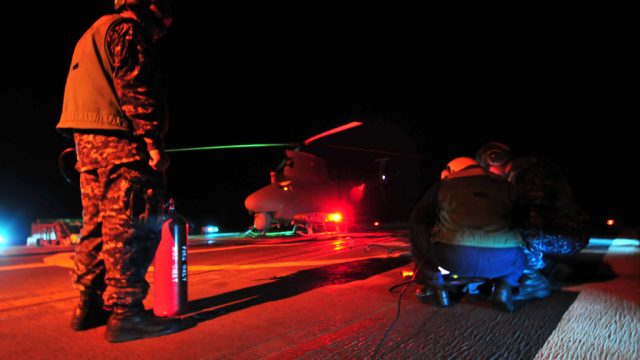Navy says Mississippi-built Fire Scout program is on target

NIGHT FLIER: The U.S. Navy insists its Fire Scout UAV program is in no danger of cancellation despite being named in a Department of Defense report last week as being in breach of the Nunn-McCurdy Amendment.
By Steve Wilson | Mississippi Watchdog
The MQ-8 Fire Scout program, a rotary wing UAV built by Northrop Grumman in Moss Point, Miss., is more than 70 percent over budget and in breach of the Nunn-McCurdy Amendment, a law designed to curtail increasing costs in weapons procurement.
According to the manager for the program, Capt. Patrick Smith, the rising costs are a product of several factors:
- The switch from the Schweizer 333 airframe (B-model) to the bigger, more capable and more costly Bell 407 (C-Model) airframe
- The reduction in the number of airframes the Navy will buy from 168 to 119
- Combining the radar and endurance upgrades into the overall program cost
Smith said the per-unit cost for the C-model airframes purchased in fiscal 2014 was about $12.5 million, versus $10.9 million per aircraft for the less capable B-model. The program’s total cost has ballooned from $2.79 billion to $3.47 billion. The Navy took out of its budget 17 airframes to be purchased over the next five years.
In the report, the DOD cited “ increased requirement for warfighter capabilities of the system and an overall reduction in the total air vehicle quantities being procured by the Navy” as the primary reasons for the cost increase. The program was listed as one of two in “critical” breach of Nunn-McCurdy, with cost overruns of 50 percent or more over the original unit cost. The average procurement unit cost increased more than 70 percent from original estimates.
“While the near-term unit cost for the MQ-8C is greater, it provides greater endurance, range and payload capacity than the MQ-8B,” Smith said.
Smith said that the greater capabilities of the C-model means the Navy needs fewer Fire Scouts to accomplish the same missions. The cut in the orders for Littoral Combat Ships from 52 to 32 is another factor in the reduced Fire Scout purchase.
According to numbers provided by the Navy, the larger C-model provides better endurance and a higher top speed.
The Fire Scout is primarily designed to supplement manned helicopters aboard air-capable U.S. Navy warships in the role of armed reconnaissance. It takes off and lands autonomously but relies on an operator aboard a ship to control it during flight.
Of the Navy’s 30 B-model Fire Scouts, five have been lost, one of which was due to airframe icing.
In 2010, one of the Fire Scouts was destroyed after it became unresponsive to commands during testing at Naval Air Station Patuxent River in Maryland and wandered into restricted airspace around Washington, D.C. Another was downed in 2011 by pro-Gaddafi rebels in Libya. Two more crashed in 2012, one off the coast of Africa and another in Afghanistan, prompting the Navy to ground the entire fleet for a few weeks.
Northrop Grumman’s Unmanned Systems Center in Moss Point also builds part of the RQ-4 Global Hawk UAV for the Air Force.
Contact Steve Wilson at swilson@watchdog.org
Get regular updates on Mississippi through our Facebook or Twitter accounts.







